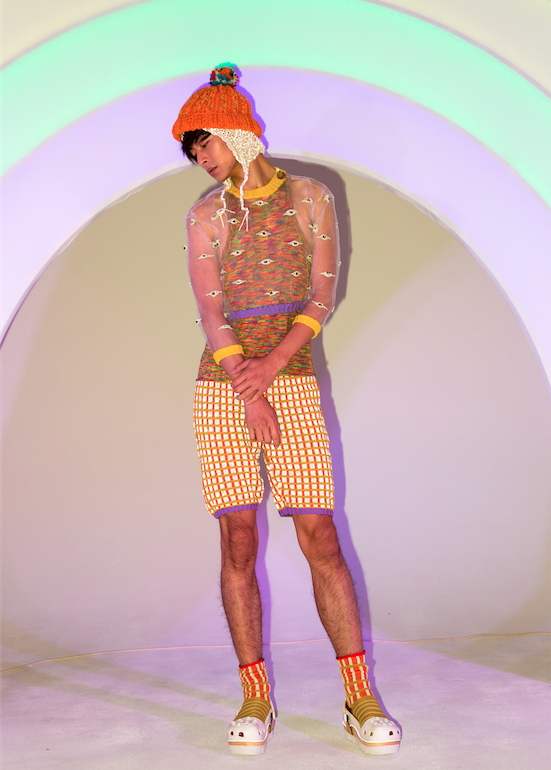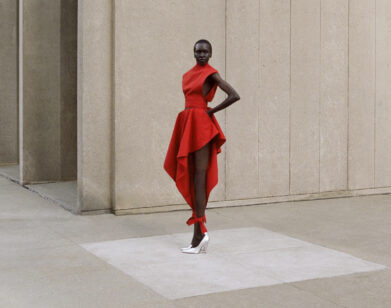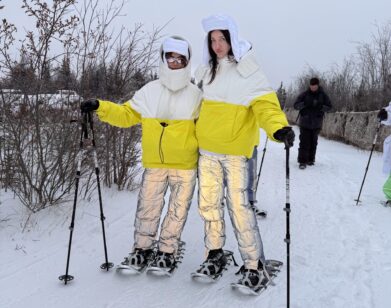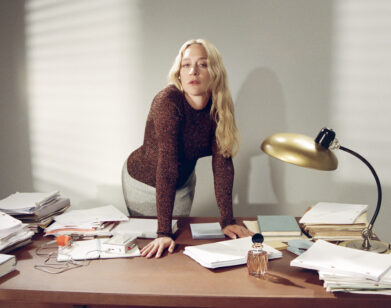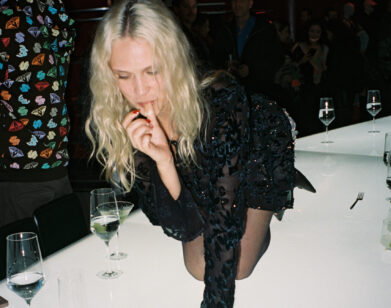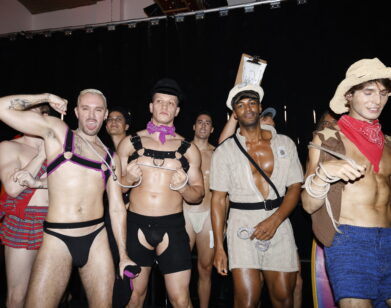Menswear Monday: Degen
There’s more to menswear than suits and ties. Every other Monday, we’re giving the fastest developing facet of fashion the attention it deserves and introducing the designers, buyers, trendsetters, and stylists you need to know.
Lindsay Degen learned to knit when she was just three years old. It shows in her collections, like the one she presented last month at New York Fashion Week. Backlit by the huge LED rainbow that washed her set in color, her designs were childishly playful and eccentric. They were even youthfully irreverent of gender norms, covering men and women alike in sheer bottoms, crop tops, and baggy sweats.
Degen’s clothes are no child’s play, though. Her work may look DIY, but her training in knitwear betrays that her amateur aesthetic is just that—a carefully combed aesthetic. Since studying textiles at RISD and Central Saint Martins, she’s built her brand around crafted knits, often in unorthodox and difficult-to-manipulate materials. “I also do a lot of proper knits,” she insists, keen on not being confined to arts and crafts. “I’m kind of trying to branch out from the DIY aesthetic.” Victoria’s Secret certainly sees the potential there: In an unlikely partnership last November, the lingerie brand commissioned nine knitted looks from Degen for their annually televised bra-hawking spectacular. Sexy and crafts-y? That’s a niche market, for sure. We got on the phone with Degen to find out, among other things, how she got into it.
DESIGNER: Lindsay Degen
BASED IN: New York
ORIGIN STORY: I grew up in Cincinnati, Ohio. It was good. My parents are liberal, so I had that, but my surroundings were really conservative. I hated that and wanted people to be more open-minded, and that’s where a lot of the base inspiration for my work comes from. I don’t really consider myself a designer, because I don’t sit down and draw things and then make technical sketches and stuff like that. I more consider myself someone who makes things and they just end up looking however they look as I make them, although there is a little bit of planning that goes in. I really like arts and crafts, and so I feel like it’s just a natural continuation of what you do as a kid that I’ve continued.
TRADEMARKS: I would say that people associate me with knitting obviously, and, I don’t necessarily like this, but I think any sort of DIY knitting is kind of my trademark. I would say it comes from not really having a big apparel background. I never went to school for apparel. I went to school for textiles, so I rely really heavily on the knitted structures that I use. However, that means that I’m not really good at reinventing the silhouette wheel because I don’t really know how to do it. So I basically design everything as a pair of sweatpants and a crew-neck. [laughs] Which is where the menswear comes in. But then after you’ve bridged that, you’re like, “Okay, I just made a crew-neck and a pair of sweatpants…” Then I try to start using the textiles in different ways in different silhouettes, and I think that’s where things get more interesting. So I usually start more masculine and end up a little more feminine.
LONDON CALLING: I think I decided to go to London because I already had an inclination for color, and I wanted to be able to see a world where that exists in a more common way. London’s really interesting because it’s an expensive place to live, but in terms of fashion-industry stuff, everything’s cheaper. You wouldn’t ever pay a crazy retainer for a publicist in London, and your studio isn’t going to cost more than your apartment in London. But that’s not really how it is here. So I think because of that, it really sets up something similar to the sort of Bushwick DIY scene that I’m coming out of, but it’s just everywhere in London. I think that’s where the similarity lies: the do-it-yourself attitude.
STYLE ICON: I actually don’t know or care that much about what’s going on in the fashion world. I obviously look at the knitting that people are doing, but that’s more of a nerd-out on knitting, not like an “I love fashion” type of thing. But I would say Lil Wayne. I feel like Lil Wayne is the perfect mixture of talent and not taking himself too seriously and that’s what my brand is all about.
COMMON THREAD: Usually the inspiration comes from some sort of social idea and sometimes it’s more serious than others. I had a season that was called “Ask, Tell” which was about the repeal of “Don’t Ask, Don’t Tell.” I thought it shouldn’t just be repealed. It should be the opposite. It should be “Ask, Tell.” But that was really just the starting point for me. I didn’t need it to be political. Other stuff that I’ve made—my parents are both geneticists. They do weird science stuff. I thought I could draw some weird parallels between knitted structures and biological structures. So I would say most of my inspiration comes from body stuff, like making people comfortable, body image, gender identity, and such. I don’t really approach it in a way that’s too in-your-face, because I don’t really like that. I want people to take what they want from it.
KNITTY GRITTY: I loved working with the Victoria’s Secret fashion show because they really let me do whatever I wanted, which was great. They let me develop this bodysuit out of fishing line that I basically demanded that they let me do. [laughs] And that made me realize that working with raw materials that aren’t proper yarn is really interesting in that it doesn’t behave how you’ve been trained or how you would anticipate anything to behave. So it’s basically relearning everything you’ve ever learned about knitting, which, to me, was really exciting and I loved that process.
Menswear Monday runs every other Monday. For more, click here.

